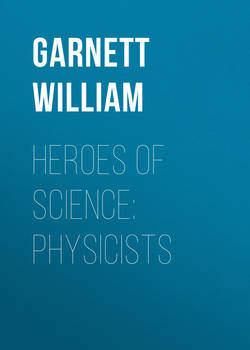Heroes of Science: Physicists

Реклама. ООО «ЛитРес», ИНН: 7719571260.
Оглавление
Garnett William. Heroes of Science: Physicists
PREFACE
INTRODUCTION
ROBERT BOYLE
BENJAMIN FRANKLIN
HENRY CAVENDISH
COUNT RUMFORD
THOMAS YOUNG
MICHAEL FARADAY
JAMES CLERK MAXWELL
CONCLUSION
Отрывок из книги
The dawn of true ideas respecting mechanics has been described in the volume of this series devoted to astronomers. At the time when the first of the following biographies opens there were a few men who held sound views respecting the laws of motion and the principles of hydrostatics. Considerable advance had been made in the subject of geometrical optics; the rectilinear propagation of light and the laws of reflection having been known to the Greeks and Arabians, whilst Willebrod Snellius, Professor of Mathematics at Leyden, had correctly enunciated the laws of refraction very early in the seventeenth century. Pliny mentions the action of a sphere of rock-crystal and of a glass globe filled with water in bringing light to a focus. Roger Bacon used segments of a glass sphere as lenses; and in the eleventh century Alhazen made many measurements of the angles of incidence and refraction, though he did not succeed in discovering the law. Huyghens developed to a great extent the undulatory theory; while Newton at the same time made great contributions to the subject of geometrical optics, decomposed white light by means of a prism, investigated the colours of thin plates, and some cases of diffraction, and speculated on the nature, properties, and functions of the ether, which was equally necessary to the corpuscular as to the undulatory theory of light, if any of the phenomena of interference were to be explained. The velocity of light was first measured by Roemer, in 1676. The camera obscura was invented by Baptista Porta, a wealthy Neapolitan, in 1560; and Kepler explained the action of the eye as an optical instrument, in 1604. Antonio de Dominis, Archbishop of Spalatro, discovered the fringe of colours produced by sunlight once reflected from the interior of a globe of water, and this led, in Newton's hands, to the complete explanation of the rainbow.
The germ of the mechanical theory of heat is to be found in the writings of Lord Bacon. The first thermometers which were blown in glass with a bulb and tube hermetically sealed, were made by a craftsman in Florence, in the time of Torricelli. The graduations on these thermometers were made by attaching little beads of coloured glass to their stems, and they were carried about Europe by members of the Florentine Academy, in order to learn whether ice melted at the same temperature in all latitudes.
.....
"Eat not to dulness; drink not to elevation.
"Speak not but what may benefit others or yourself; avoid trifling conversation.
.....